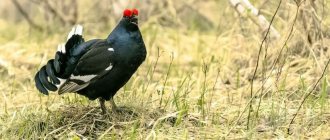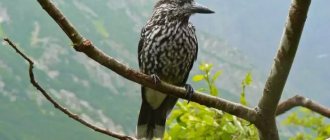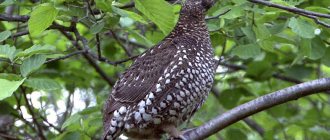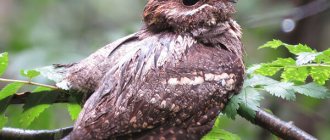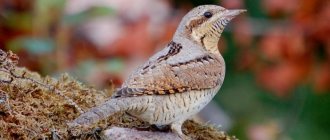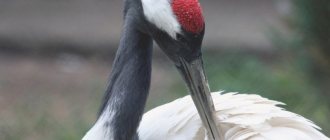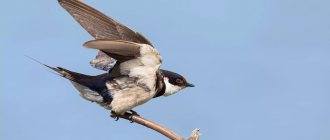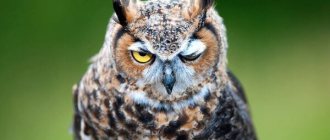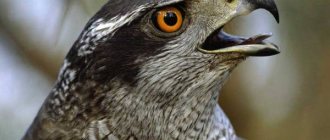- Wild animals
- >>
- Birds
The capercaillie is a majestic bird, in which one can feel strength and solidity. The beautiful color of the feathers, the raised beak, and the fluffy tail resembling a fan involuntarily make you admire the bird for a long time. This is the most noble and largest bird of the black grouse breed. Wood grouse are characterized by particular clumsiness, heavy gait, timidity and noisy flight. They are unable to fly long distances. Males have a more spectacular plumage color. You can find out more information about this wonderful bird from this article.
Origin of the species and description
Photo: Capercaillie
The species was first classified by Linnaeus under its current binomial bird name in Systema naturae in 1758. Now we have a more expanded and accurate description of the taxonomic features of the capercaillie.
Here are a few subspecies, listed from west to east:
- cantabricus (Cantabrian wood grouse) - Castroviejo, 1967: found in western Spain;
- aquitanicus - 1915: found in the Pyrenees, Spain and France;
- major - 1831: found in Central Europe (Alps and Estonia);
- rudolfi - 1912 : found in Southeastern Europe (from Bulgaria to Ukraine);
- urogallus - 1758: found in Scandinavia and Scotland;
- karelicus - found in Finland and Karelia;
- lonnbergi - found on the Kola Peninsula;
- pleskei - found in the Republic of Belarus, in the central part of Russia;
- obsoletus - found in the northern European part of Russia;
- volgensis - 1907: found in the southeastern European part of Russia;
- uralensis - 1886: found in the Urals and Western Siberia;
- parvirostris - 1896: Stone capercaillie.
The subspecies is characterized by an increase in the amount of white on the underparts of males from west to east, from almost entirely black with a few white spots below in western and central Europe to almost pure white in Siberia, where the common capercaillie occurs. In females there is much less variation.
The native Scottish population, which became extinct between 1770 and 1785, was probably a distinct subspecies, although it was never formally described. The same can be said about the extinct Irish species.
Winter
When severe frosts occur, the bird arranges its shelter in deep snow . This happens in such a way that the male climbs onto a high branch and falls like a stone into the soft snow, thereby forming a tunnel. Such snow holes serve birds as shelter for several days. If an enemy is wandering nearby, the capercaillie noisily gets out and takes off from under the snow.
Appearance and features
Photo: Wood grouse bird
Capercaillie are easily distinguished by size and color. The male is much larger than the hen. It is one of the most sexually dimorphic in size of living bird species, surpassed only by the larger bustard species and a select few members of the pheasant family.
Males have a length from 74 to 110 cm depending on the subspecies, a wingspan from 90 to 1.4 m, an average weight of 4.1 kg - 6.7 kg. The largest specimen recorded in captivity weighed 7.2 kg. The body feathers are dark gray to dark brown, and the chest feathers are dark metallic green with a black tint. The belly and underparts vary from black to white depending on the subspecies. The beak is white and pink, the bare skin near the eyes is distinctly red.
Video: Capercaillie
The female is much smaller, weighing about half as much. The body length of laying hens from beak to tail is approximately 54–64 cm, the wingspan is 70 cm, and the weight is 1.5–2.5 kg, with an average of 1.8 kg. The feathers on the upper parts are brown with black and silver stripes; on the underside they are lighter and bright yellow. This color is necessary for the female to camouflage herself as much as possible during the nesting period.
Interesting fact: Both sexes have webbed feet, which provide protection during the cold season. They have rows of small, elongated horny claws that provide a snowshoe effect. This led to the German surname "Rauhfußhühner", which literally translates to "rough-footed chickens". These so-called “tacks” make a clear mark in the snow. The sex of the bird is easy to distinguish by the size of the marks.
Small chicks with their mysterious coloring resemble a female; this coloring is a passive protection from predators. At the age of about three months, at the end of summer, they gradually molt, acquiring the adult plumage of roosters and hens. The eggs of different subspecies are approximately the same size and shape; they are variegated in color with brown spots.
Where does the capercaillie live?
Photo: Female wood grouse
The capercaillie is a sedentary bird species that breeds in northern parts of Europe and Western and Central Asia in mature coniferous forests with a diverse species composition and relatively open, gently sloping structure.
At one time, wood grouse could be found throughout the taiga forests of northern and northeastern Eurasia in cold temperate latitudes and in the coniferous forest belt of the mountain ranges of warm temperate Europe. In Great Britain, the number approached zero, but was restored by individuals brought from Sweden. These birds can be found in the Swiss Alps, the Jura, the Austrian and Italian Alps. The species is completely extinct in Belgium. In Ireland it was common until the 17th century, but became extinct in the 18th.
The species is widespread and is a common bird in forest regions in the following countries:
- Norway;
- Sweden;
- Finland;
- Russia;
- Romania.
In addition, wood grouse is found in Spain, Asia Minor, the Carpathians, and Greece. From the 18th to 20th centuries, the number and range of wood grouse decreased significantly. During the Soviet era, deforestation was associated with the retreat of the capercaillie population closer to the north, and in some southern regions it disappeared completely.
In Siberia lives the stone capercaillie, which is distinguished by its mating behavior and coloration. Its habitat coincides with the distribution of larch taiga. These borders extend beyond the Arctic Circle, reaching Indigirka and Kolyma. In the east, the stone capercaillie reaches the coast of the Far Eastern seas; in the south, the border runs along the Sikhote-Alin mountains. Most of the range in the west runs along Lake Baikal and Lower Tunguska.
Now you know where the wood grouse lives. Let's see what he eats.
What does wood grouse eat?
Photo: Capercaillie in winter
The wood grouse is a highly specialized herbivore that feeds almost exclusively on blueberry leaves and berries, with some grasses and fresh sedge shoots in the summer. Young chicks depend on food rich in protein in the first weeks and therefore mainly hunt insects and spiders. The number of insects is greatly influenced by the weather - dry and warm conditions contribute to the rapid growth of chicks, while cold and rainy weather leads to high mortality.
The capercaillie diet consists of various types of food, including:
- tree buds;
- leaves;
- forest berries;
- shoots;
- flowers;
- seeds;
- insects;
- herbs.
In autumn, wood grouse eat larch needles. In winter, when high snow cover prevents access to ground vegetation, birds spend almost the entire day and night in the trees, feeding on spruce and pine needles, as well as beech and rowan buds.
Interesting fact: Most of the year, capercaillie droppings have a solid consistency, but after the blueberries ripen, which become dominant in the diet, the feces become shapeless and bluish-black.
To digest rough winter food, birds need pebbles: small gastroliths, which birds actively search for and swallow. Wood grouse have very muscular stomachs, so the stones function like a mill and break the spines and buds into small particles. In addition, symbiotic bacteria also help digest plant material. On short winter days, the capercaillie feeds almost constantly.
Showing
This period of life in wood grouse can be observed regardless of the time of year. Males flock to the lek, occupying meadows and clearings - these places will serve in the future as a lek.
Here, capercaillie, with the help of their songs, attract the attention of females and fight with each other, thus finding out who has the advantage in strength. The melody is the same for everyone; when it is released, the birds spread their wings a little, stretch their necks and fluff their tails. When the females arrive, a real massacre begins, during which the weakest representatives may die.
Features of character and lifestyle
Photo: Capercaillie in the forest
The capercaillie is adapted to its original habitats - old coniferous forests with a rich internal structure and dense ground vegetation. They find shelter in the crowns of young trees and use open spaces during flight. Wood grouse are not very capable fliers due to their body mass and short, rounded wings. When they take off, they make a sudden rumbling noise that scares away predators. Due to their body size and wingspan, they avoid young and dense forests during flight. During flight, they often rest using short gliding phases. Their feathers make a whistling sound.
Females, especially brood hens with young chicks, require resources: food plants, small insects for the chicks, covered with dense young trees or tall plants, old trees with horizontal branches for sleeping. These criteria best correspond to old forest stands with spruce and pine. Birds lead a mostly sedentary lifestyle, but can move from the mountains to the valleys, making seasonal migrations.
The capercaillie is a cautious bird with good hearing and vision. He can be aggressive if he sees an unfamiliar animal nearby. Bird gathering places rarely change. Mostly prefers solitude; crowds of birds are not for them. In the morning and evening they stay awake in search of food. During the day they rest in the trees. In winter, in very cold weather, a capercaillie can hide in the snow from the frost and stay there for a couple of days.
Interesting facts about the bird
- In the 18th and 19th centuries, wood grouse were a favorite bird for sport and commercial hunting. Males were always hunted in the spring, during mating, when the birds lose their vigilance. During his song, a displaying male capercaillie throws his head back, rolls his eyes, puffs up, opens his tail and lowers his wings. At the same time, he does not hear or see anything around him. It even happened that the bird was not afraid of the first shot and did not fly away if the hunter missed, letting him get very close to him.
- Both in the wild and in captivity, wood grouse can give birth to common offspring with black grouse, which are called “mezhnyak”.
- In winter, wood grouse live in flocks and mainly gather on tree branches. However, in severe frosts, birds can hide in the snow, falling into it directly from a tree. Wood grouse then make a nesting chamber in the snow, in which they remain constantly, flying out only to feed.
Social structure and reproduction
Photo: Great wood grouse
The capercaillie breeding season depends on spring weather and vegetation development, but generally this period begins from March to April and lasts until May or June. But some species can breed in summer, autumn and even winter. Three-quarters of the breeding season involves courtship—simply territorial competition between neighboring males.
The male inspects himself with tail feathers raised and flared, neck straight, beak pointing upward, wings extended and lowered, and begins his typical aria to impress the females. Shocking is a series of double clicks, similar to a falling ping-pong ball, that gradually intensify to a popping sound, similar to a champagne cork, followed by a grinding sound.
Towards the end of the courtship season, females arrive on the site. Males continue to display on the ground: this is the main courtship season. The male flies into open space nearby and continues his display. The female crouches and makes a sound when she is ready to mate. Wood grouse are polygamous birds and if there is more than one contender, the alpha male wins and has sexual intercourse with the females.
About three days after copulation, the female begins to lay eggs. After 10 days the masonry is filled. The average clutch size is eight eggs, but can be as many as 12. Incubation lasts 26–28 days depending on weather and altitude.
Interesting fact: At the beginning of the incubation period, females are very sensitive to noise and quickly leave the nest. Before hatching, they are more diligent and remain in place despite the danger, bending down to their nest, which is usually hidden under the low branches of a young tree.
All eggs hatch almost simultaneously, after which the female and chicks leave the nest, where they are most vulnerable. When hatching, the chicks are completely covered in downy feathers, but cannot maintain their body temperature, which is 41° C. In cold and rainy weather, the chicks are warmed by the female every few minutes and throughout the night.
The chicks search for food on their own and hunt mainly for insects. They grow quickly and most of the energy consumed is converted into muscle. At the age of 3-4 weeks, the chicks perform their first short flights. From this time on, they begin to sleep in trees.
Advantages of a screw
In appearance, capercaillie fasteners do not differ from ordinary hardware, but this is not so. If you use such a mount in your work, it will be a plus, because:
- Reliably connects parts to each other, withstands heavy loads;
- The thread is placed at an angle of 60 degrees, which creates excellent strength of the object;
- It has galvanized protection, which prevents it from rusting under the influence of negative environments.
These properties have made the screw a popular fastener that is in constant demand.
Natural enemies of wood grouse
Photo: Wood grouse bird
Known predators of wood grouse are the common lynx (L. lynx) and the gray wolf (Canis lupus). Although they prefer slightly larger prey. In addition, there are a number of predators that prefer to take capercaillie eggs and chicks, but can also attack adult individuals if they manage to successfully ambush wary birds.
This category of predators includes:
- pine martens (M. martes);
- stone martens (M. foina);
- brown bears (Ursus arctos);
- wild boars (Sus scrofa);
- red foxes (Vulpes vulpes).
In Sweden, western capercaillie are the main prey of the golden eagle (Aquila chrysaetos). In addition, wood grouse are often attacked by the goshawk (Accipiter gentilis). It attacks chicks more often, but it happens that adults also become victims. The eagle owl (Bubo bubo) sometimes catches capercaillie of any age and size. The white-tailed eagle (H. albicilla) prefers to hunt waterfowl, but it is noted that it has been spotted hunting wood grouse near the White Sea.
However, the main predator for wood grouse is and remains man. This is a traditional game bird that was and is hunted with guns and dogs throughout Europe and Asia. This includes sport hunting and hunting for food. In Russia (before 1917), wood grouse were brought in large quantities to capital markets, and even larger quantities were consumed locally. Since hunting is now restricted in many countries, sport hunting has become a tourism resource, especially in Central European countries.

